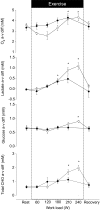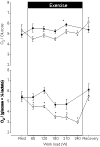Non-selective beta-adrenergic blockade prevents reduction of the cerebral metabolic ratio during exhaustive exercise in humans
- PMID: 18403423
- PMCID: PMC2536587
- DOI: 10.1113/jphysiol.2008.151449
Non-selective beta-adrenergic blockade prevents reduction of the cerebral metabolic ratio during exhaustive exercise in humans
Erratum in
- J Physiol. 2011 Dec 15;589(Pt 24):6247
Abstract
Intense exercise decreases the cerebral metabolic ratio of oxygen to carbohydrates [O(2)/(glucose + (1/2)lactate)], but whether this ratio is influenced by adrenergic stimulation is not known. In eight males, incremental cycle ergometry increased arterial lactate to 15.3 +/- 4.2 mm (mean +/- s.d.) and the arterial-jugular venous (a-v) difference from -0.02 +/- 0.03 mm at rest to 1.0 +/- 0.5 mm (P < 0.05). The a-v difference for glucose increased from 0.7 +/- 0.3 to 0.9 +/- 0.1 mm (P < 0.05) at exhaustion and the cerebral metabolic ratio decreased from 5.5 +/- 1.4 to 3.0 +/- 0.3 (P < 0.01). Administration of a non-selective beta-adrenergic (beta(1) + beta(2)) receptor antagonist (propranolol) reduced heart rate (69 +/- 8 to 58 +/- 6 beats min(-1)) and exercise capacity (239 +/- 42 to 209 +/- 31 W; P < 0.05) with arterial lactate reaching 9.4 +/- 3.6 mm. During exercise with propranolol, the increase in a-v lactate difference (to 0.5 +/- 0.5 mm; P < 0.05) was attenuated and the a-v glucose difference and the cerebral metabolic ratio remained at levels similar to those at rest. Together with the previous finding that the cerebral metabolic ratio is unaffected during exercise with administration of the beta(1)-receptor antagonist metropolol, the present results suggest that the cerebral metabolic ratio decreases in response to a beta(2)-receptor mechanism.
Figures



Comment in
-
Lactate: a major and crucial player in normal function of both muscle and brain.J Physiol. 2008 Jun 1;586(11):2665-6. doi: 10.1113/jphysiol.2008.155416. J Physiol. 2008. PMID: 18515304 Free PMC article. No abstract available.
Similar articles
-
Maintained cerebral metabolic ratio during exercise in patients with beta-adrenergic blockade.Clin Physiol Funct Imaging. 2009 Nov;29(6):420-6. doi: 10.1111/j.1475-097X.2009.00889.x. Epub 2009 Jul 30. Clin Physiol Funct Imaging. 2009. PMID: 19659603
-
Cerebral oxygenation decreases during exercise in humans with beta-adrenergic blockade.Acta Physiol (Oxf). 2009 Jul;196(3):295-302. doi: 10.1111/j.1748-1716.2008.01946.x. Epub 2008 Nov 28. Acta Physiol (Oxf). 2009. PMID: 19053964 Clinical Trial.
-
Lactate: a major and crucial player in normal function of both muscle and brain.J Physiol. 2008 Jun 1;586(11):2665-6. doi: 10.1113/jphysiol.2008.155416. J Physiol. 2008. PMID: 18515304 Free PMC article. No abstract available.
-
Lactate fuels the human brain during exercise.FASEB J. 2008 Oct;22(10):3443-9. doi: 10.1096/fj.08-106104. Epub 2008 Jul 24. FASEB J. 2008. PMID: 18653766 Review.
-
Quantification of anaerobic energy production during intense exercise.Med Sci Sports Exerc. 1998 Jan;30(1):47-52. doi: 10.1097/00005768-199801000-00007. Med Sci Sports Exerc. 1998. PMID: 9475643 Review.
Cited by
-
Cerebral non-oxidative carbohydrate consumption in humans driven by adrenaline.J Physiol. 2009 Jan 15;587(1):285-93. doi: 10.1113/jphysiol.2008.162073. Epub 2008 Nov 17. J Physiol. 2009. PMID: 19015195 Free PMC article.
-
Cerebral perfusion, oxygenation and metabolism during exercise in young and elderly individuals.J Physiol. 2013 Apr 1;591(7):1859-70. doi: 10.1113/jphysiol.2012.244905. Epub 2012 Dec 10. J Physiol. 2013. PMID: 23230234 Free PMC article.
-
Mitochondrial Transport in Glycolysis and Gluconeogenesis: Achievements and Perspectives.Int J Mol Sci. 2021 Nov 23;22(23):12620. doi: 10.3390/ijms222312620. Int J Mol Sci. 2021. PMID: 34884425 Free PMC article. Review.
-
A functional account of stimulation-based aerobic glycolysis and its role in interpreting BOLD signal intensity increases in neuroimaging experiments.Neurosci Biobehav Rev. 2023 Oct;153:105373. doi: 10.1016/j.neubiorev.2023.105373. Epub 2023 Aug 25. Neurosci Biobehav Rev. 2023. PMID: 37634556 Free PMC article. Review.
-
Glucose metabolism following human traumatic brain injury: methods of assessment and pathophysiological findings.Metab Brain Dis. 2015 Jun;30(3):615-32. doi: 10.1007/s11011-014-9628-y. Epub 2014 Nov 21. Metab Brain Dis. 2015. PMID: 25413449 Free PMC article. Review.
References
-
- Bogert LW, van Lieshout JJ. Non-invasive pulsatile arterial pressure and stroke volume changes from the human finger. Exp Physiol. 2005;90:437–446. - PubMed
-
- Borg G. Simple rating for estimation of perceived exertion. In: Borg G, editor. Physical Work and Effort. New York: Pergamon; 1975. pp. 39–46.
-
- Bradac GB, Simon RS, Heidsieck CH. Angiographically verified transient alteration of intercranial arteries and veins in dependence of different CO2 tension. Neuroradiol. 1976;10:257–262. - PubMed
-
- Dalsgaard MK. Fuelling cerebral activity in exercising man. J Cereb Blood Flow Metab. 2006;26:731–750. - PubMed
Publication types
MeSH terms
Substances
LinkOut - more resources
Full Text Sources
Miscellaneous

